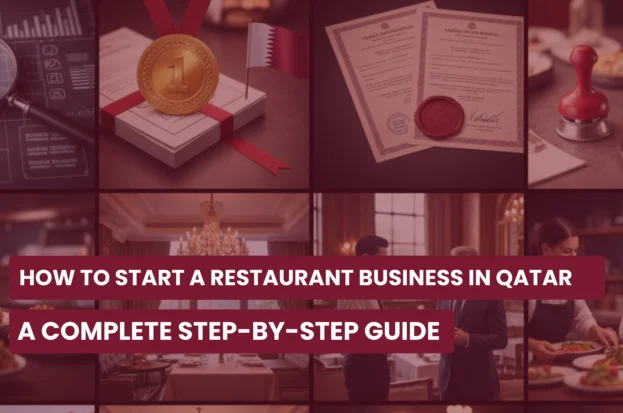The restaurant market in Qatar presents a significant opportunity today. With a rising tourist count, an affluent local population, a large expatriate community and strong governmental push for economic diversification, the F&B sector is booming. If you’re looking to start a restaurant business in Qatar, now is a timely moment to plan carefully and enter with the right strategy. This guide covers every major step you’ll need, from understanding the market to compliance, launch and growth.
Understanding the Market in Qatar
Market Growth & Trends
Qatar’s dining-out culture is expanding thanks to higher disposable incomes, growing tourism and major events. Investors and consultants highlight the F&B sector as one of the fastest-growing in the region.
Consumer Habits & Preferences
With a mix of locals, expatriates and visitors, there’s strong demand for both international cuisine and local-inspired dining concepts. Unique niches (e.g., premium dessert outlets, fast-casual chains) are especially attractive.
Niche Opportunities
- International cuisine for expatriate segments
- Experience-based dining (luxury, themed)
- Delivery & cloud kitchen models
- Food & beverage tie-ins with tourism and events
Legal & Regulatory Framework
Choosing a Business Entity
Select the right legal structure; common options include LLC, branch, or partnership. Under the Ministry of Commerce and Industry (MOCI) you’ll find the requirements.
Licences & Permits for a Restaurant
Several key licences must be obtained:
- Commercial Registration (CR) from MOCI.
- Trade/Business licence to authorise restaurant activity.
- Food Establishment / Health & Safety permit via the Ministry of Public Health (MOPH) and municipal inspections.
- Municipal zoning and building approvals (including fire/civil-defence).
- If you plan to serve alcohol, a separate liquor licence is required.
Foreign Ownership & Sponsorship
For many business types, a local Qatari sponsor or partner may be required, though reforms have expanded options for 100% foreign ownership in some cases.
Additional Compliance & Obligations
Once operational, monitor obligations such as correct commercial activity declarations, invoice standards, valid licensing, and renewals.
Business Plan & Financial Planning
Developing Your Business Plan
Your plan should cover your concept (type of cuisine), target market, menu pricing, operational hours, expected covers per day, and revenue/cost projections.
Estimating Startup & Running Costs
- Premises lease or purchase (high in prime locations)
- Fit-out, kitchen equipment, dining furniture
- Licensing, professional fees (consultants, legal)
- Staffing and training
- Marketing to launch and sustain
Pricing Strategy & Break-Even
Calculate your break-even point (covers × average spend, minus fixed and variable costs). Ensure you include margin for cost inflation, seasonal dips, and supply disruptions.
Location & Fit-Out
Choosing an Ideal Location
High-footfall areas like malls, hotels, tourist districts or food street clusters often bring ready-customers. Parking, accessibility, visibility and lease terms are crucial.
Lease & Fit-Out Considerations
Negotiate favourable lease terms (length, escalation, fit-out rights). Fit-out must comply with local building codes, fire & civil-defence standards and health regulations.
Guest Experience & Design
Your design should reflect your concept and local culture (air-conditioning, outdoor dining in milder seasons, premium finish for luxury segments). Investing in ambiance can aid positioning and premium pricing.
Supplier & Inventory Management
Sourcing & Logistics
Decide between local supply (fresh produce, perishables) and imports (speciality items, branded foods). Consider cold-chain challenges in a desert climate—good refrigeration, storage and logistics matter.
Kitchen Equipment & Layout
Optimize kitchen flow (prep → cook → plating → service) and storage (dry, chilled, frozen). Choose equipment for durability, energy efficiency and local maintenance support.
Controls
Implement systems for food cost tracking, wastage reduction, spoilage monitoring—these feed into profitability. Good stock control helps maintain menu margins and operational smoothness.
Staffing & Workforce
Hiring Strategy
In Qatar, the workforce typically includes expatriate staff for kitchen, service and management, plus local hires in certain roles. Immigration/work-visas must be managed.
Labour Law Essentials
Comply with local labour laws: working hours, leave entitlements, termination rules, wages system. Non-compliance can lead to penalties.
Training & Culture
Ensure staff are trained in hospitality standards, food safety (HACCP, hygiene) and guest service expectations. Cultural sensitivity (local customs, language) matters.
Operational Efficiency
Monitor metrics such as staff turnover, labour cost % of revenue, productivity per cover—these are critical in restaurant profitability.
Marketing & Launch Strategy
Pre-Launch Tactics
- Social media teasers and influencer collaborations
- Soft-opening for selected guests
- Loyalty programmes or grand opening events
Digital Presence
Ensure you have a website, local listing (Google My Business), and presence on food-delivery apps which are popular in Qatar.
Partnerships & Events
Tie-ups with hotels, resorts, event venues (meetings, exhibitions) can deliver large guest flows. Seasonal menus and event tie-ins can boost traffic.
Ongoing Promotion
Loyalty programmes, targeted promotions, seasonal offers, and guest experience enhancements help retain and grow business. Keep analysing what works for your audience.
Operations & Compliance
Food Safety & Hygiene
Regular inspections by health authorities in Qatar must be expected—ensure ongoing compliance in kitchen design, staff training, and records of cleaning and pest control.
& Safety, Fire Compliance
Premises must adhere to civil-defence fire safety approvals, signage permits, and environmental permits if applicable.
POS / Inventory / Accounting Systems
Use modern POS systems integrated with inventory and analytics to track food cost, labour cost, guest check averages and other KPIs.
Monitoring Key Performance Indicators (KPIs)
- Covers per day
- Average spend per cover
- Food cost percentage
- Labour cost percentage
- Guest satisfaction scores
Challenges & Risk Management
Common Pitfalls
- High rental/lease cost in peak locations
- Poor location choice
- Supply chain delays or import restrictions
- Staff turnover or insufficient training
- Under-capitalisation during early months
Managing Seasonal / Event-Driven Demand
Qatar hosts international tournaments, large exhibitions and seasonal tourism flows—plan for peaks and troughs in demand.
Contingency Planning
Have backup plans for supply disruptions, regulatory changes, labor issues, and economic slowdowns. Set aside contingency funds in your financial plan.
Exit Strategy & Growth Opportunities
Scaling Up
Once your first outlet is stable, consider expanding via a second location, franchise model, or cloud-kitchen brand extension.
Exit Options
Selling the business, handing over management, or converting into a brand licensing model are viable options. A clear exit plan improves investment attractiveness.
How RAG Global Can Support
At RAG Global, support includes company formation in Qatar, licensing assistance, local market advisory, partner/sponsor services, location selection, and fit-out management to streamline your launch.
Conclusion
Starting a restaurant business in Qatar is a promising venture—but success depends on meticulous planning, compliance with regulations, strategic location, and operational excellence. From concept and licensing to hiring and growth, each step must be managed carefully. Reach out to RAG Global to get expert advisory and local partner support to turn your restaurant vision into reality.


October 31, 2025
How to Start a Logistics Business in Qatar (For Foreign Investors)

October 23, 2025
Qatar’s Ministry of Commerce & Industry Launches 20 New Digital Services

October 10, 2025
QR 12 Billion in New Contracts: Why Entrepreneurs Should Watch Qatar Closely

September 23, 2025
If You’re in Your 20s, Starting a Company in Qatar Could Be Your Smartest Move — Especially with New Company Formation in Qatar
